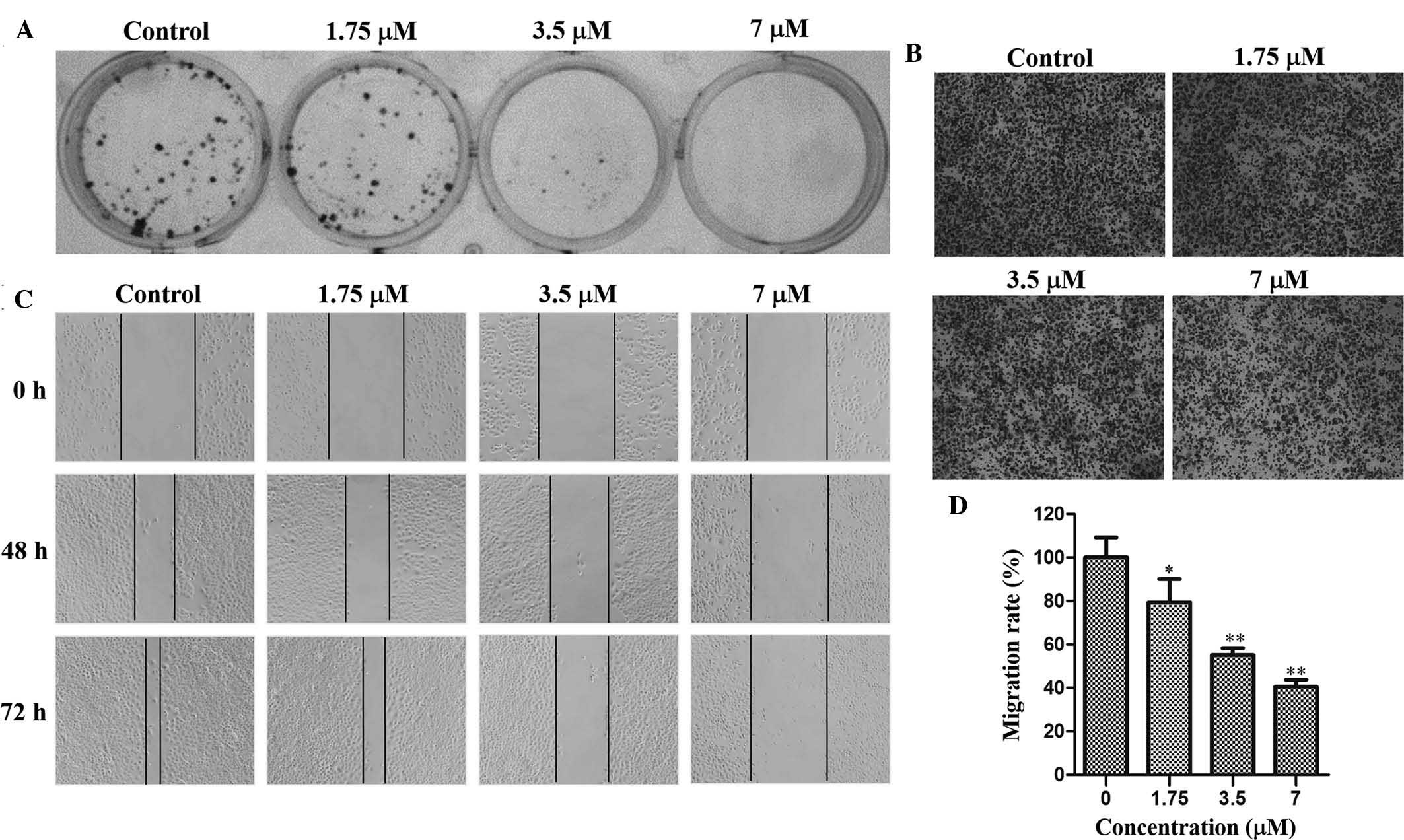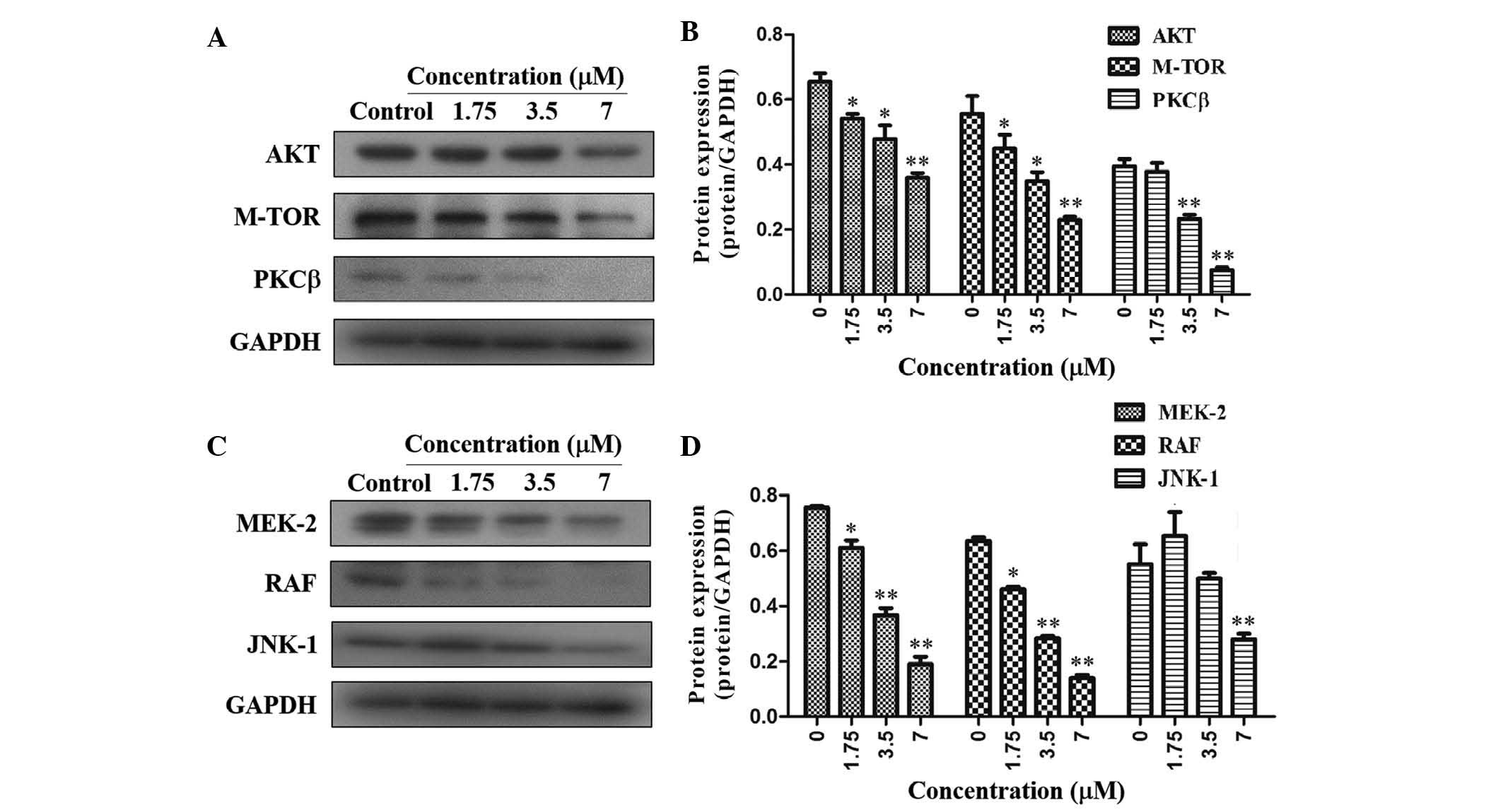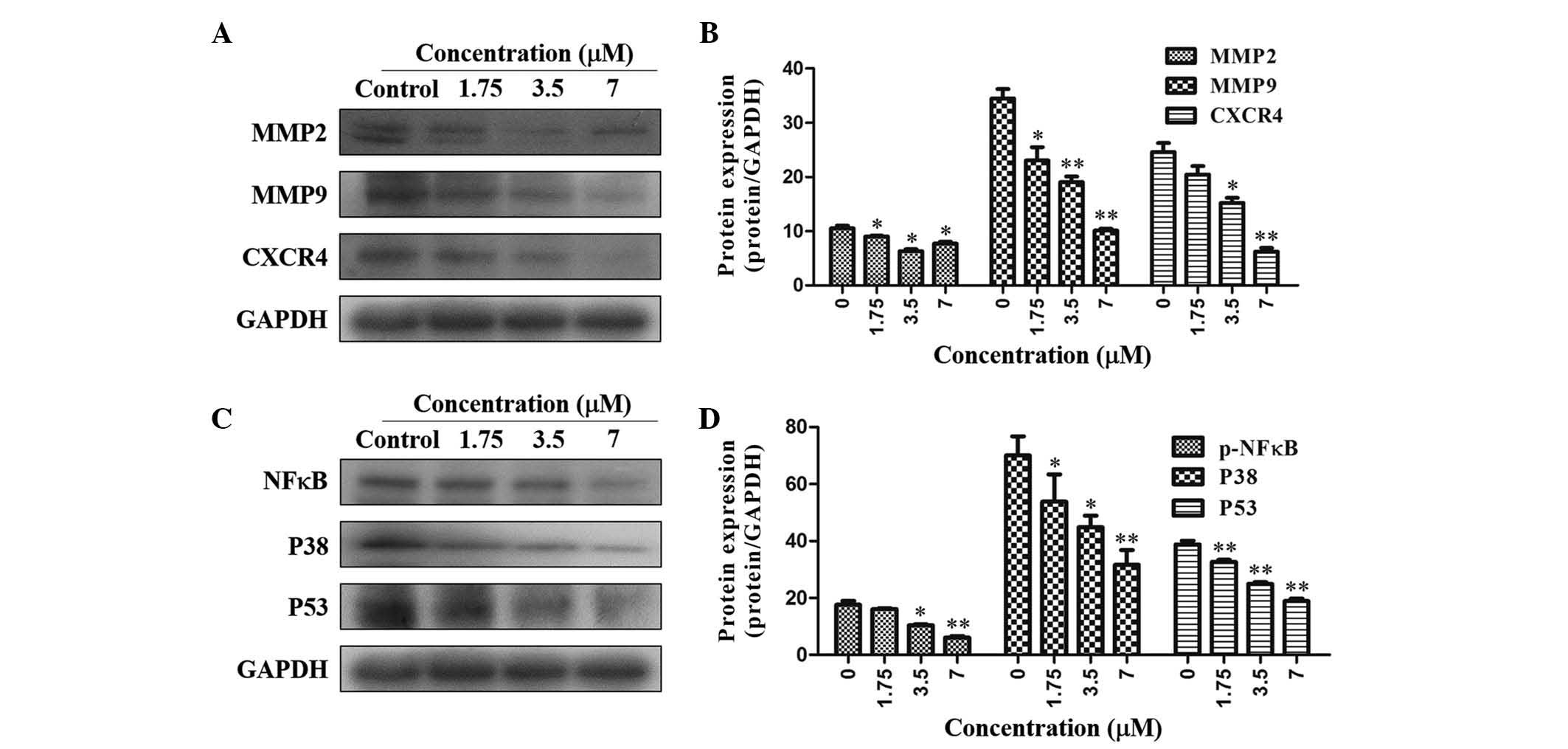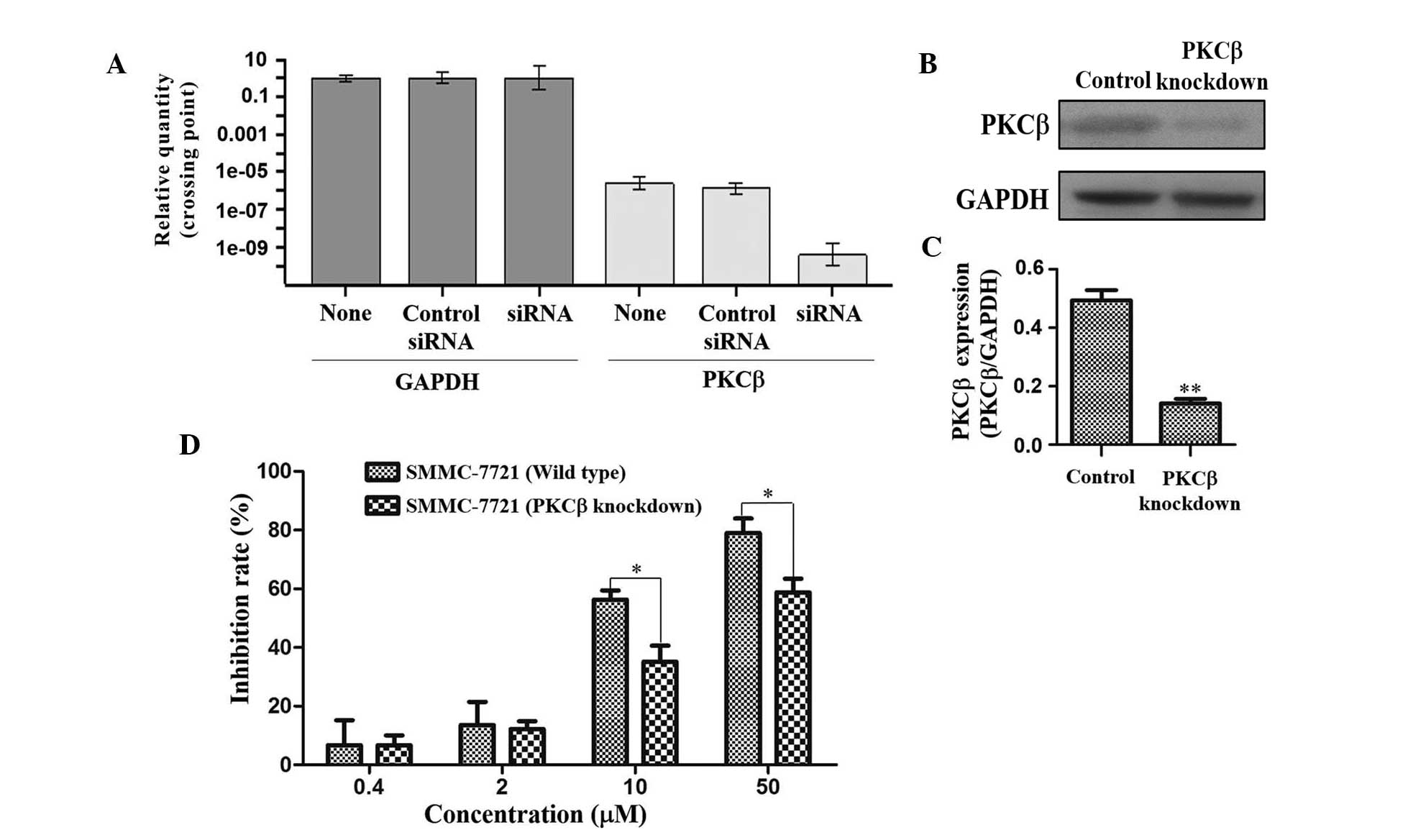|
1
|
Shen B, Chu ES, Zhao G, Man K, Wu CW,
Cheng JT, Li G, Nie Y, Lo CM, Teoh N, et al: PPARgamma inhibits
hepatocellular carcinoma metastases in-vivo and in mice. Br J
Cancer. 106:1486–1494. 2012. View Article : Google Scholar : PubMed/NCBI
|
|
2
|
Yodkeeree S, Chaiwangyen W, Garbisa S and
Limtrakul P: Curcumin, demethoxycurcumin and bisdemethoxycurcumin
differentially inhibit cancer cell invasion through the
down-regulation of MMPs and uPA. J Nutr Biochem. 20:87–95. 2009.
View Article : Google Scholar
|
|
3
|
Zhen C, Chen L, Zhao Q, Liang B, Gu YX,
Bai ZF, Wang K, Xu X, Han QY, Fang DF, et al: Gankyrin promotes
breast cancer cell metastasis by regulating Rac1 activity.
Oncogene. 32:3452–3460. 2013. View Article : Google Scholar
|
|
4
|
Kim GD, Oh J, Park HJ, Bae K and Lee SK:
Magnolol inhibits angiogenesis by regulating ROS-mediated apoptosis
and the PI3K/AKT/mTOR signaling pathway in mES/EB-derived
endothelial-like cells. Int J Oncol. 43:600–610. 2013.PubMed/NCBI
|
|
5
|
Song MK, Kim YJ, Song M, Choi HS, Park YK
and Ryu JC: Polycyclic aromatic hydrocarbons induce migration in
human hepatocellular carcinoma cells (HepG2) through reactive
oxygen species-mediated p38 MAPK signal transduction. Cancer Sci.
102:1636–1644. 2011. View Article : Google Scholar : PubMed/NCBI
|
|
6
|
Hidalgo M and Eckhardt SG: Development of
matrix metal-loproteinase inhibitors in cancer therapy. J Natl
Cancer Inst. 93:178–193. 2001. View Article : Google Scholar : PubMed/NCBI
|
|
7
|
Zhang XX, Fu ZY, Zhang Z, Miao C, Xu P, et
al: Microcystin-LR promotes melanoma cell invasion and enhances
matrix metal-loproteinase-2/-9 expression mediated by NFκB
activation. Environ Sci Technol. 46:11319–11326. 2012. View Article : Google Scholar : PubMed/NCBI
|
|
8
|
Chambers AF and Matrisian LM: Changing
views of the role of matrix metalloproteinases in metastasis. J
Natl Cancer Inst. 89:1260–1270. 1997. View Article : Google Scholar : PubMed/NCBI
|
|
9
|
Wang C, Gao D, Guo K, Kang X, Jiang K, Sun
C, Li Y, Sun L, Shu H, Jin G, et al: Novel synergistic antitumor
effects of rapamycin with bortezomib on hepatocellular carcinoma
cells and orthotopic tumor model. BMC Cancer. 12:1662012.
View Article : Google Scholar : PubMed/NCBI
|
|
10
|
Perdue G, Blomster RN, Blake DA and
Farnsworth NR: South-American plants II: Taspine isolation and
anti-inflammatory activity. J Pharm Sci. 68:124–126. 1979.
View Article : Google Scholar : PubMed/NCBI
|
|
11
|
Rollinger JM, Schuster D, Baier E,
Ellmerer EP, Langer T and Stuppner H: Taspine: Bioactivity-guided
isolation and molecular ligand-target insight of a potent
acetylcholinesterase inhibitor from Magnolia x soulangiana. J Nat
Prod. 69:1341–1346. 2006. View Article : Google Scholar : PubMed/NCBI
|
|
12
|
Porras-Reyes BH, Lewis WH, Roman J,
Simchowitz L and Mustoe TA: Enhancement of wound healing by the
alkaloid taspine defining mechanism of action. Proc Soc Exp Biol
Med. 203:18–25. 1993. View Article : Google Scholar : PubMed/NCBI
|
|
13
|
Itokawa H, Ichihara Y, Mochizuki M,
Enomori T, Morita H, Shirota O, Inamatsu M and Takeya K: A
cytotoxic substance from Sangre De Grado. Chem Pharm Bull.
39:1041–1042. 1991. View Article : Google Scholar : PubMed/NCBI
|
|
14
|
Zhang YM, He LC, Meng L, Luo WJ and Xu XM:
Suppression of tumor-induced angiogenesis by taspine isolated from
Radix et Rhizoma Leonticis and its mechanism of action in vivo.
Cancer Lett. 262:103–113. 2008. View Article : Google Scholar : PubMed/NCBI
|
|
15
|
Zhang YM, Jiang Q, Wang N, Dai B, Chen Y
and He L: Effects of taspine on proliferation and apoptosis by
regulating caspase-3 expression and the ratio of Bax/Bcl-2 in A431
Cells. Phytother Res. 25:357–364. 2011.
|
|
16
|
Gao HP, Su P, Shi YL, Shen X, Zhang Y,
Dong J and Zhang J: Discovery of novel VEGFR-2 inhibitors. Part II:
Biphenyl urea incorporated with salicylaldoxime. Eur J Med Chem.
90:232–240. 2015. View Article : Google Scholar
|
|
17
|
Zinda MJ, Johnson MA, Paul JD, Horn C,
Konicek BW, Lu ZH, Sandusky G, Thomas JE, Neubauer BL, Lai MT, et
al: AKT-1,-2, and-3 are expressed in both normal and tumor tissues
of the lung, breast, prostate, and colon. Clin Cancer Res.
7:2475–2479. 2001.PubMed/NCBI
|
|
18
|
Hay N: The Akt-mTOR tango and its
relevance to cancer. Cancer Cell. 8:179–183. 2005. View Article : Google Scholar : PubMed/NCBI
|
|
19
|
Faivre S, Kroemer G and Raymond E: Current
development of mTOR inhibitors as anticancer agents. Nat Rev Drug
Discov. 5:671–688. 2006. View
Article : Google Scholar : PubMed/NCBI
|
|
20
|
Philippi A, Roschmann E, Tores F,
Lindenbaum P, Benajou A, Germain-Leclerc L, Marcaillou C, Fontaine
K, Vanpeene M, Roy S, et al: Haplotypes in the gene encoding
protein kinase c-beta (PRKCB1) on chromosome 16 are associated with
autism. Mol Psychiatr. 10:950–960. 2005. View Article : Google Scholar
|
|
21
|
Lintas C, Sacco R, Garbett K, Mirnics K,
Militerni R, Bravaccio C, Curatolo P, Manzi B, Schneider C, Melmed
R, et al: Involvement of the PRKCB1 gene in autistic disorder:
Significant genetic association and reduced neocortical gene
expression. Mol Psychiatry. 14:705–718. 2009. View Article : Google Scholar
|
|
22
|
Chuang SM, Wang IC and Yang JL: Roles of
JNK, p38 and ERK mitogen-activated protein kinases in the growth
inhibition and apoptosis induced by cadmium. Carcinogenesis.
21:1423–1432. 2000. View Article : Google Scholar : PubMed/NCBI
|
|
23
|
Luo W, Wang X, Zheng L, Zhan Y, Zhang D,
Zhang J and Zhang Y: Brucine suppresses colon cancer cells growth
via mediating KDR signalling pathway. J Cell Mol Med. 17:1316–1324.
2013. View Article : Google Scholar : PubMed/NCBI
|
|
24
|
Balan V, Leicht DT, Zhu J, Balan K, Kaplun
A, Singh-Gupta V, Qin J, Ruan H, Comb MJ and Tzivion G:
Identification of novel in vivo Raf-1 phosphorylation sites
mediating positive feedback Raf-1 regulation by extracellular
signal-regulated kinase. Mol Biol Cell. 17:1141–1153. 2006.
View Article : Google Scholar : PubMed/NCBI
|
|
25
|
Lou L, Ye W, Chen Y, Wu S, Jin L, He J,
Tao X, Zhu J, Chen X, Deng A, et al: Ardipusilloside inhibits
survival, invasion and metastasis of human hepatocellular carcinoma
cells. Phytomedicine. 19:603–608. 2012. View Article : Google Scholar : PubMed/NCBI
|
|
26
|
Adams LS, Phung S, Yee N, Seeram NP, Li L
and Chen S: Blueberry phytochemicals inhibit growth and metastatic
potential of MDA-MB-231 breast cancer cells through modulation of
the phosphatidylinositol 3-kinase pathway. Cancer Res.
70:3594–3605. 2010. View Article : Google Scholar : PubMed/NCBI
|
|
27
|
Chen QY, Zheng Y, Jiao DM, Chen FY, Hu HZ,
Wu YQ, Song J, Yan J, Wu LJ and Lv GY: Curcumin inhibits lung
cancer cell migration and invasion through Rac1-dependent signaling
pathway. J Nutr Biochem. 25:177–185. 2014. View Article : Google Scholar : PubMed/NCBI
|
|
28
|
Chen Y, Stamatoyannopoulos G and Song CZ:
Down-regulation of CXCR4 by inducible small interfering RNA
inhibits breast cancer cell invasion in vivo. Cancer Res.
63:4801–4804. 2003.PubMed/NCBI
|
|
29
|
Shen HM and Tergaonkar V: NF kappaB
signaling in carcinogenesis and as a potential molecular target for
cancer therapy. Apoptosis. 14:348–363. 2009. View Article : Google Scholar : PubMed/NCBI
|
|
30
|
Wang Z, Banerjee S, Li Y, Rahman KMW,
Zhang Y and Sarkar FH: Down-regulation of notch-1 inhibits invasion
by inactivation of nuclear factor-kappaB, vascular endothelial
growth factor, and matrix metalloproteinase-9 in pancreatic cancer
cells. Cancer Res. 66:2778–2784. 2006. View Article : Google Scholar : PubMed/NCBI
|
|
31
|
O'Connor PM, Jackman J, Jondle D, Bhatia
K, Magrath I and Kohn KW: Role of the p53 tumor-suppressor gene in
cell-cycle arrest and radiosensitivity of Burkitt's lymphoma cell
lines. Cancer Res. 53:4776–4780. 1993.PubMed/NCBI
|
|
32
|
Sharma GD, He J and Bazan HE: p38 and
ERK1/2 coordinate cellular migration and proliferation in
epithelial wound healing: Evidence of cross-talk activation between
MAP kinase cascades. J Biol Chem. 278:21989–21997. 2003. View Article : Google Scholar : PubMed/NCBI
|
|
33
|
Surdez D, Benetkiewicz M, Perrin V, Han
ZY, Pierron G, Ballet S, Lamoureux F, Rédini F, Decouvelaere AV,
Daudigeos-Dubus E, et al: Targeting the EWSR1-FLI1 oncogene-induced
protein kinase PKCβ abolishes ewing sarcoma growth. Cancer Res.
72:4494–4503. 2012. View Article : Google Scholar : PubMed/NCBI
|














